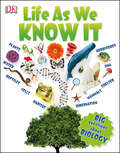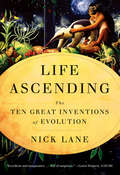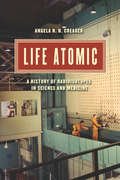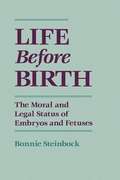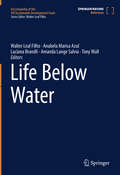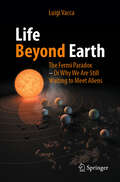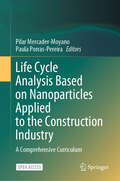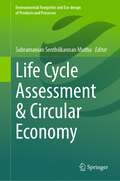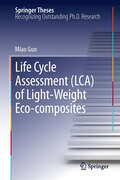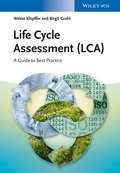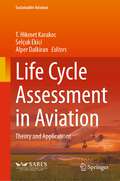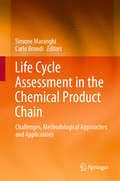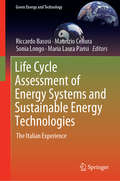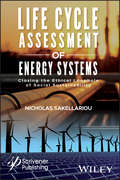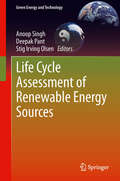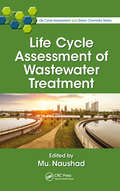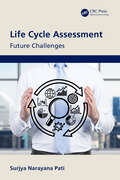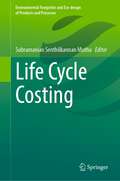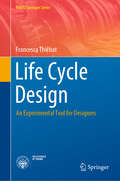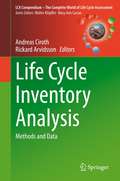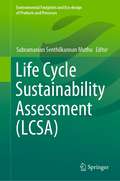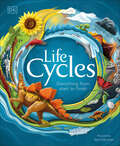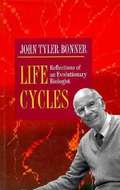- Table View
- List View
Life As We Know It (Big Questions)
by DKAs far as we know, Earth is the only inhabited planet in the Universe. So what makes Earth such an ideal place for life to survive? And how did it all get started? Life as We Know It goes back to the beginnings of life on our planet, explaining to middle grade readers how it emerged under hostile conditions from a chemical soup as a simple self-contained unit: the cell. Key biological themes, such as how cells work, produce energy, and reproduce are explained in simple terms. This knowledge is then used to explain how more complex organisms live. The book also looks at the wide variety of plant and animal life on Earth and how it evolved, and introduces the features and characteristics of members of the six kingdoms of life. Young readers will learn how life forms have adapted to occupy particular niches and what can happen if something upsets this balance. Lavishly illustrated with images from DK's extensive natural history photo library, this encyclopedia is a visual feast as well as a thorough treatment of biology. Through DK's unique visual style, scientific ideas that might appear intimidating in a textbook are made lucid at a glance.
Life Ascending: The Ten Great Inventions of Evolution
by Nick Lane"Original and awe-inspiring . . . an exhilarating tour of some of the most profound and important ideas in biology."--New Scientist Where does DNA come from? What is consciousness? How did the eye evolve? Drawing on a treasure trove of new scientific knowledge, Nick Lane expertly reconstructs evolution's history by describing its ten greatest inventions--from sex and warmth to death--resulting in a stunning account of nature's ingenuity.
Life Atomic: A History of Radioisotopes in Science and Medicine (Synthesis Ser.)
by Angela N. CreagerAfter World War II, the US Atomic Energy Commission (AEC) began mass-producing radioisotopes, sending out nearly 64,000 shipments of radioactive materials to scientists and physicians by 1955. Even as the atomic bomb became the focus of Cold War anxiety, radioisotopes represented the government’s efforts to harness the power of the atom for peace—advancing medicine, domestic energy, and foreign relations. In Life Atomic, Angela N. H. Creager tells the story of how these radioisotopes, which were simultaneously scientific tools and political icons, transformed biomedicine and ecology. Government-produced radioisotopes provided physicians with new tools for diagnosis and therapy, specifically cancer therapy, and enabled biologists to trace molecular transformations. Yet the government’s attempt to present radioisotopes as marvelous dividends of the atomic age was undercut in the 1950s by the fallout debates, as scientists and citizens recognized the hazards of low-level radiation. Creager reveals that growing consciousness of the danger of radioactivity did not reduce the demand for radioisotopes at hospitals and laboratories, but it did change their popular representation from a therapeutic agent to an environmental poison. She then demonstrates how, by the late twentieth century, public fear of radioactivity overshadowed any appreciation of the positive consequences of the AEC’s provision of radioisotopes for research and medicine.
Life Before Birth: The Moral and Legal Status of Embryos and Fetuses (2nd Edition)
by Bonnie SteinbockThis book provides a framework for thinking clearly and coherently about the unborn. The book's thesis, the "interest view," states that all and only beings who have interests have moral standing, and only beings who possess conscious awareness have interests. The chapters apply the interest view, and explore the moral and legal aspects of a wide range of issues.
Life Below Water (Encyclopedia of the UN Sustainable Development Goals)
by Walter Leal Filho Tony Wall Luciana Brandli Anabela Marisa Azul Amanda Lange SalviaThe problems related to the process of industrialisation such as biodiversity depletion, climate change and a worsening of health and living conditions, especially but not only in developing countries, intensify. Therefore, there is an increasing need to search for integrated solutions to make development more sustainable. The United Nations has acknowledged the problem and approved the “2030 Agenda for Sustainable Development”. On 1st January 2016, the 17 Sustainable Development Goals (SDGs) of the Agenda officially came into force. These goals cover the three dimensions of sustainable development: economic growth, social inclusion and environmental protection. The Encyclopedia of the UN Sustainable Development Goals comprehensively addresses the SDGs in an integrated way. It encompasses 17 volumes, each one devoted to one of the 17 SDGs. This volume is dedicated to SDG 14 “Conserve and sustainably use the oceans, seas and marine resources for sustainable development". Marine and coastal bio-resources, play an essential role in human well-being and social and economic development. This volume addresses this sustainability challenge providing the description of a range of terms, which allows a better understanding and fosters knowledge about it.Concretely, the defined targets are:Prevent and significantly reduce marine pollution of all kinds, in particular from land-based activities, including marine debris and nutrient pollutionSustainably manage and protect marine and coastal ecosystems to avoid significant adverse impacts, including by strengthening their resilience, and take action for their restoration in order to achieve healthy and productive oceansMinimize and address the impacts of ocean acidification, including through enhanced scientific cooperation at all levelsEffectively regulate harvesting and end overfishing, illegal, unreported and unregulated fishing and destructive fishing practices and implement science-based management plans, in order to restore fish stocks in the shortest time feasible, at least to levels that can produce maximum sustainable yield as determined by their biological characteristicsConserve at least 10 per cent of coastal and marine areas, consistent with national and international law and based on the best available scientific informationProhibit certain forms of fisheries subsidies which contribute to overcapacity and overfishing, eliminate subsidies that contribute to illegal, unreported and unregulated fishing and refrain from introducing new such subsidies, recognizing that appropriate and effective special and differential treatment for developing and least developed countries should be an integral part of the World Trade Organization fisheries subsidies negotiation 16Increase the economic benefits to small island developing states and least developed countries from the sustainable use of marine resources, including through sustainable management of fisheries, aquaculture and tourism Increase scientific knowledge, develop research capacity and transfer marine technology, taking into account the Intergovernmental Oceanographic Commission Criteria and Guidelines on the Transfer of Marine Technology, in order to improve ocean health and to enhance the contribution of marine biodiversity to the development of developing countries, in particular small island developing states and least developed countriesProvide access for small-scale artisanal fishers to marine resources and marketsEnhance the conservation and sustainable use of oceans and their resources by implementing international law as reflected in the United Nations Convention on the Law of the Sea, which provides the legal framework for the conservation and sustainable use of oceans and their resources, as recalled in paragraph 158 of “The future we want”Editorial Board</di
Life Beyond Earth
by Athena Coustenis Thérèse EncrenazWhat is life and where can it exist? What searches are being made to identify conditions for life on other worlds? If extraterrestrial inhabited worlds are found, how can we explore them? In this book, two leading astrophysicists provide an engaging account of where we stand in our quest for habitable environments, in the Solar System and beyond. Starting from basic concepts, the narrative builds scientifically, including more in-depth material as boxed additions to the main text. The authors recount fascinating recent discoveries from space missions and observations using ground-based telescopes, of possible life-related artefacts in Martian meteorites, extrasolar planets, and subsurface oceans on Europa, Titan and Enceladus. They also provide a forward look to future missions. This is an exciting, informative read for anyone interested in the search for habitable and inhabited planets, and an excellent primer for students in astrobiology, habitability, planetary science and astronomy.
Life Beyond Earth: The Fermi Paradox -- Or Why We Are Still Waiting to Meet Aliens
by Luigi VaccaThis book analyzes the likelihood of intelligent civilizations from two different standpoints: firstly, using the famous Drake equation and, secondly, by analyzing some of the most popular hypotheses about the likely behavior of intelligent alien civilizations. The existence of intelligent extraterrestrial civilizations in the universe is one of the most intriguing scientific and philosophical problems. Is it possible that we are the only intelligent species in this incredibly vast universe? Enrico Fermi, one of the greatest physicists of the 20th century, posed the same question during a lunch with his colleagues in 1950. What are the implications for a universe where there is only one intelligent species? The universe may be stranger than we think.
Life Concepts from Aristotle to Darwin: On Vegetable Souls
by Lucas John MixThis book traces the history of life-concepts, with a focus on the vegetable souls of Aristotle, investigating how they were interpreted and eventually replaced by evolutionary biology. Philosophers have long struggled with the relationship between physics, physiology, and psychology, asking questions of organization, purpose, and agency. For two millennia, the vegetable soul, nutrition, and reproduction were commonly used to understand basic life and connect it to “higher” animal and vegetable life. Cartesian dualism and mechanism destroyed this bridge and left biology without an organizing principle until Darwin. Modern biology parallels Aristotelian vegetable life-concepts, but remains incompatible with the animal, rational, subjective, and spiritual life-concepts that developed through the centuries. Recent discoveries call for a second look at Aristotle’s ideas – though not their medieval descendants. Life remains an active, chemical process whose cause, identity, and purpose is self-perpetuation.
Life Cycle Analysis Based on Nanoparticles Applied to the Construction Industry: A Comprehensive Curriculum
by Pilar Mercader-Moyano Paula Porras-PereiraThis open access book describes in the recent years, there has been a notable upsurge in the use of nanomaterials, particularly within the construction and building sectors. The incorporation of nanoparticles introduces noteworthy changes in the physico-mechanical and physical–chemical characteristics of construction materials. Despite the acknowledged advantages of employing nanomaterials, uncertainties persist regarding their widespread adoption in development and applications, especially concerning potential environmental and human health implications. A crucial aspect in thoroughly assessing the environmental impacts of nanoproducts is the imperative quantification of effects on ecosystems and human health throughout the entire life cycle of these products. The indispensable utilization of a comprehensive tool, such as Life Cycle Assessment, becomes paramount in gaining a nuanced understanding of potential environmental and health challenges, thereby ensuring the environmental sustainability of nanomaterials. This academic publication endeavours to provide nanoproduct manufacturers, construction industry professionals, and waste managers with the necessary knowledge to comprehend the environmental and health impacts associated with the manufacturing, application, and disposal processes of nanoproducts used in the construction industry. This contribution aims to enhance their personal and professional development, consequently bolstering their employability at the European level. A thorough comprehension of potential releases throughout the entire life cycle of nanoproducts and their potential effects is imperative for ensuring the safe and sustainable utilization of these innovative materials. The application of life cycle thinking emerges as a pivotal component in appropriately evaluating the potential impacts associated with nanomaterial releases.
Life Cycle Assessment & Circular Economy (Environmental Footprints and Eco-design of Products and Processes)
by Subramanian Senthilkannan MuthuThis contributed volume offers several cases in life cycle assessment (LCA) and implementation of circular economy principles across different industries. LCA is a tool which is utilized to measure the environmental footprints of various products from inception through disposal. Circular economy, a related concept, presents a meaningful alternative to a traditional linear economy as it seeks possible ways to reduce waste, recover resources at the end of a product’s life, and channel them back into production, thus significantly reducing environmental impacts. LCA and CE complement each other, as the former can be used to meaningfully assess possibilities for the latter. The combination of the principles of CE and LCA enable product developers to quantify the environmental performance of various products, processes and supply chain configurations in order to make progress toward sustainability.
Life Cycle Assessment (LCA) of Light-Weight Eco-composites
by Miao GuoMiao Guo's PhD thesis provides scientific insights into the environmental issues related to biocomposites based on starch-polyvinyl alcohol (PVOH) blends. The author contributes significantly to the methodological issues underlying the Life Cycle Assessment (LCA) modelling approach. As well as presenting complete LCA inventories using primary data from a variety of sources, Guo develops a new modelling approach incorporating the process-oriented biogeochemistry model Denitrification-Decomposition (DNDC) into site-specific LCA studies to simulate carbon and nitrogen dynamics in the wheat agro-ecosystem. This thesis addresses important LCA data quality issues by using comprehensive sensitivity and uncertainty analyses and has resulted in a large number of publications in internationally renowned journals.
Life Cycle Assessment (LCA): A Guide to Best Practice
by Walter Klöpffer Birgit GrahlThis first hands-on guide to ISO-compliant Life Cycle Assessment (LCA) makes this powerful tool immediately accessible to both professionals and students. Following a general introduction on the philosophy and purpose of LCA, the reader is taken through all the stages of a complete LCA analysis, with each step exemplified by real-life data from a major LCA project on beverage packaging. Measures as carbon and water footprint, based on the most recent international standards and definitions, are addressed. Written by two pioneers of LCA, this practical volume is targeted at first-time LCA users but equally makes a much-valued reference for more experienced practitioners. From the content: * Goal and Scope Definition * Life Cycle Inventory Analysis * Life Cycle Impact Assessment * Interpretation, Reporting and Critical Review * From LCA to Sustainability Assessment and more.
Life Cycle Assessment in Aviation: Theory and Applications (Sustainable Aviation)
by T. Hikmet Karakoc Alper Dalkiran Selçuk EkiciLife Cycle Assessment in Aviation: Theory and Applications provides readers with a comprehensive analysis that examines various elements within the aviation sector, including aircraft operations, maintenance and repair activities, aircraft gas turbine engine processes, airport auxiliary vehicles, airport operations, airport construction, airport access traffic, and airport wastes. The book’s content has been meticulously crafted to address the specific needs and interests of a diverse audience encompassing researchers, engineering students, and civil aviation organization officials. Readers will find valuable insights and up-to-date information about the latest developments in the aviation field, serving as a valuable resource for their investigations and studies.
Life Cycle Assessment in the Chemical Product Chain: Challenges, Methodological Approaches and Applications
by Simone Maranghi Carlo BrondiThis book outlines the methodologies, approaches and tools for modelling chemicals in a Life Cycle Assessment (LCA) perspective, and also covers the main advantages and drawbacks of applying LCA to chemical processes. In the first part of this book, authors pay close attention to the limitations of modelling the environmental and social impacts of chemical processes, providing valuable insights to the problems of the Life Cycle Inventory (LCI) analysis for chemical processes. In the second part of this book, readers will learn about the LCA application to chemical processes in the laboratory and industrial scale. In each chapter of this book, readers will also find specific case studies on the modelling and application of LCA in the chemical industry.
Life Cycle Assessment of Energy Systems and Sustainable Energy Technologies: The Italian Experience (Green Energy and Technology)
by Riccardo Basosi Maurizio Cellura Sonia Longo Maria Laura ParisiThis book deals with the application of life cycle assessment (LCA) methodology to sustainable energy systems and technologies. It reviews the state-of-the-art of the Italian experiences on the LCA applied to energy, and the most recent results from research in this field, with a particular focus on renewables, bio-energy and sustainable solutions. The contributors describe in detail the applications of LCA to various energy system topics, including: • electricity production, smart energy grids and energy storage systems;• renewable energy production from biomass;• production of biodiesel from microalgae;• environmental impacts of biomass power plants; and• geothermal energy production. These topics are supported by critical reviews and case studies, with discussions of Italian examples, demonstrating LCA’s application to various energy systems. A particular focus is placed on bio-energies and bio-energy systems, demonstrating how LCA can be used for optimal bio-energy production. This book offers an opportunity for researchers and advanced practitioners in the field of LCA to learn more about the application of LCA methodology to energy systems and technologies. It will also be of interest to students, as it enables them to understand the environmental impacts of energy systems and sustainable energy technologies, through the analysis of their life cycles.
Life Cycle Assessment of Energy Systems: Closing the Ethical Loophole of Social Sustainability
by Nicholas SakellariouEnergy and sustainability are two of the most important and often most misunderstood subjects in our world today. As these two subjects have grown in importance over the last few decades, interest in the Life Cycle Assessment (LCA) model has grown as well, as a potentially crucial tool in understanding and striving towards sustainability in energy systems. Not just wind and solar systems, but all energy systems, need to be understood through this model. Wind and solar power have the potential to decentralize the U.S. energy system by offering local communities electricity and economic support, depending on the scale and design of projects. Nevertheless, every energy technology potentially faces environmental costs, lay and expert opposition, and risks to public health. Engineers play a central role as designers, builders, and operators in energy systems. As they extend their expertise into electrical, mechanical and chemical fields, from fossil fuel-based systems to renewable energy systems, “sustainability” is steadily becoming one of the key criteria engineers apply in their work. This groundbreaking new study argues that engineering cultures foster sustainability by adopting assumptions and problem-solving practices as part of their identities when designing and building engineering projects. This work examines the politics of creating, utilizing, and modifying Life Cycle Assessment (LCA) in the construction of renewable energy systems. The only volume of its kind ever written, it is a must-have for any engineer, scientist, manager, or other professional working in or interested in Life Cycle Assessment and its relation to energy systems and impact on environmental and economic sustainability.
Life Cycle Assessment of Renewable Energy Sources
by Anoop Singh Deepak Pant Stig Irving OlsenGovernments are setting challenging targets to increase the production of energy and transport fuel from sustainable sources. The emphasis is increasingly on renewable sources including wind, solar, geothermal, biomass based biofuel, photovoltaics or energy recovery from waste. What are the environmental consequences of adopting these other sources? How do these various sources compare to each other? Life Cycle Assessment of Renewable Energy Sources tries to answer these questions based on the universally adopted method of Life Cycle Assessment (LCA). This book introduces the concept and importance of LCA in the framework of renewable energy sources and discusses the key issues in conducting their LCA. This is followed by an in-depth discussion of LCA for some of the most common bioenergy sources such as agricultural production systems for biogas and bioethanol, biogas from grass, biodiesel from palm oil, biodiesel from used cooking oil and animal fat, Jatropha biodiesel, lignocellulosic bioethanol, ethanol from cassava and sugarcane molasses, residential photovoltaic systems, wind energy, microalgal biodiesel, biohydrogen and biomethane. Through real examples, the versatility of LCA is well emphasized. Written by experts all over the globe, the book is a cornucopia of information on LCA of bioenergy systems and provides a platform for stimulation of new ideas and thoughts. The book is targeted at practitioners of LCA and will become a useful tool for researchers working on different aspects of bioenergy.
Life Cycle Assessment of Wastewater Treatment (Life Cycle Assessment and Green Chemistry Series)
by Mu. NaushadLife Cycle Assessment of Wastewater Treatment addresses in detail the required in-depth life cycle assessment of wastewater treatment. This is to meet the special demands placed upon wastewater treatment processes, due to both the limited quantity and often low quality of water supplies. Wastewater management clearly plays a central role in achieving future water security in a world where water stress is expected to increase. Life cycle assessment (LCA) can be used as a tool to evaluate the environmental impacts associated with wastewater treatment and potential improvement options. This unique volume will focus on the analysis of wastewater treatment plants (WWTPs), using a life cycle assessment (LCA) approach. Key Features: Focuses on the analysis of wastewater treatment plants using a life cycle assessment (LCA) approach Discusses unconventional water sources such as recycled wastewater, brackish groundwater and desalinated seawater Explains life cycle assessment in detail, which has become one of the reference methods used to assess the environmental performance of processes over their complete life cycle, from raw material extraction, infrastructure construction and operation to final dismantling Explores a technique (LCA) that is becoming increasingly popular amongst researchers in the water treatment field nowadays because of its holistic approach Based on the real life experiences, the subject of wastewater is presented in simple terms and made accessible to anyone willing to learn and experiment
Life Cycle Assessment: Future Challenges
by Surjya Narayana PatiThis book offers an itemized analysis of Life Cycle Assessment (LCA), for use in any processes, products, services, industries, organizations and so forth. Various challenges faced during applications of LCA, and its extension are discussed including their benefits. Further, the book provides practical examples of LCA in different core sectors, such as cement and construction. Each chapter functions as a stand-alone unit within the book and defines its individual role within the overall concept of LCA. Features: Covers Life Cycle Assessment (LCA) and future challenges including its practical applications as climate change tool. Connects life cycle management and LCA/environmental management. Explains benefits of LCA studies for both internal and external purpose in terms of various impact parameters. Identifies different raw materials or alternate energy mediums for changing inputs to reduce environmental impacts. Discusses extension of LCA concept like LCC, LCSA, SCLA, and OLCA. This book is aimed at professionals in all engineering areas and environmental studies.
Life Cycle Costing (Environmental Footprints and Eco-design of Products and Processes)
by Subramanian Senthilkannan MuthuLife Cycle Costing (LCC) is a well-known and popular method to evaluate the economic sustainability, which as the term implies is structured on the life cycle of a product or process. LCC is a method primarily consisting of estimating the total cost of a product, taking into account the whole life cycle of the product as well as the direct and external costs. It is one of the important methods and tools under the sustainability umbrella. This book describes the concept of LCC and offers several interesting case studies.
Life Cycle Design: An Experimental Tool for Designers (PoliTO Springer Series)
by Francesca ThiebatThis book proposes an economic and environmental assessment tool to help private and public building designers and owners determine the global sustainability value of green buildings from a life cycle perspective. As it demonstrates, sustainable life cycle tools for building design and construction can help to achieve successfully integrated architecture. The first part of the book defines the relationship between environmental and economic aspects in a sustainable design approach and illustrates how life cycle methodologies, including Life Cycle Assessment and Life Cycle Costing, can be applied to life cycle design. Further, it highlights methods for calculating costs from LCA data, taking into consideration both discounted cash flow and external costs. In turn, the second part of the book presents an experimental design model, the Life Cycle Design Model (LCDM), which is based on a life cycle design approach that can be used to produce two different outcomes based on two assessment levels. The first assessment level involves creating a grid, called a Design Matrix, which is useful in the design process. The second assessment level involves drawing on LCA and LCC results to develop a user-friendly tool for designers and other actors involved in the building process so that they can assess the most sustainable design option using €CO, a factor that combines the environmental and energy effects of the building system with time and costs. Selected case studies illustrate the practical application of life cycle analysis and show how reflecting the environmental impacts and costs can improve the sustainability of buildings. The LCDM represents a transdisciplinary tool for the design team and, at the same time, allows information on users’ needs and building performance to be communicated between experts and non-experts.
Life Cycle Inventory Analysis: Methods and Data (LCA Compendium – The Complete World of Life Cycle Assessment)
by Andreas Ciroth Rickard ArvidssonLife Cycle Inventory (LCI) Analysis is the second phase in the Life Cycle Assessment (LCA) framework. Since the first attempts to formalize life cycle assessment in the early 1970, life cycle inventory analysis has been a central part. Chapter 1 “Introduction to Life Cycle Inventory Analysis“ discusses the history of inventory analysis from the 1970s through SETAC and the ISO standard. In Chapter 2 “Principles of Life Cycle Inventory Modeling”, the general principles of setting up an LCI model and LCI analysis are described by introducing the core LCI model and extensions that allow addressing reality better. Chapter 3 “Development of Unit Process Datasets” shows that developing unit processes of high quality and transparency is not a trivial task, but is crucial for high-quality LCA studies. Chapter 4 “Multi-functionality in Life Cycle Inventory Analysis: Approaches and Solutions” describes how multi-functional processes can be identified. In Chapter 5 “Data Quality in Life Cycle Inventories”, the quality of data gathered and used in LCI analysis is discussed. State-of-the-art indicators to assess data quality in LCA are described and the fitness for purpose concept is introduced. Chapter 6 “Life Cycle Inventory Data and Databases“ follows up on the topic of LCI data and provides a state-of-the-art description of LCI databases. It describes differences between foreground and background data, recommendations for starting a database, data exchange and quality assurance concepts for databases, as well as the scientific basis of LCI databases. Chapter 7 “Algorithms of Life Cycle Inventory Analysis“ provides the mathematical models underpinning the LCI. Since Heijungs and Suh (2002), this is the first time that this aspect of LCA has been fundamentally presented. In Chapter 8 “Inventory Indicators in Life Cycle Assessment”, the use of LCI data to create aggregated environmental and resource indicators is described. Such indicators include the cumulative energy demand and various water use indicators. Chapter 9 “The Link Between Life Cycle Inventory Analysis and Life Cycle Impact Assessment” uses four examples to discuss the link between LCI analysis and LCIA. A clear and relevant link between these phases is crucial.
Life Cycle Sustainability Assessment (Environmental Footprints and Eco-design of Products and Processes)
by Subramanian Senthilkannan MuthuEnvironmental Life Cycle Assessment (ELCA) that was developed about three decades ago demands a broadening of its scope to include lifecycle costing and social aspects of life cycle assessment as well, drawing on the three-pillar or ‘triple bottom line’ model of sustainability, which is the result of the development of the Life Cycle Sustainability Assessment (LCSA). LCSA refers to the evaluation of all environmental, social and economic negative impacts and benefits in decision-making processes towards more sustainable products throughout their life cycle. Combination of environmental and social life cycle assessments along with life cycle costing leads to life cycle sustainability assessment (LCSA). This book highlights various aspects of life cycle sustainability assessment (LCSA).
Life Cycles: Everything from Start to Finish (DK Life Cycles)
by DKTake a look into the circle of life through the life cycles of the planet and everything on it!Everything begins and everything ends — but what happens in between? Find out in this stunning nature book. Learn about human life and development, processes in nature, how animals change over time, how the universe was formed and so much more. This illustrated children&’s book for ages 7-11 includes: • More than 60 life cycles featured • Stunning photographs that capture key moments during a life cycle, like penguin chicks huddling together to keep warm and the beauty of an orchid in full bloom • Bite-size facts and stats about every animal, plant, planet and habitat featured • A great new angle on the world, the universe and our place in it If you&’re looking for facts about the universe then this is the book for you! Based on key concepts found in the STEM learning curriculum, Life Cycles captures life on the planet through captivating illustrations and photography, amazing facts and easy-to-read text. You&’ll take a closer look at the life cycles of environments, and extinct animals like the dinosaurs, too! The life cycles in this reference book have been carefully chosen to give you an amazing overview of the universe, and how everything is linked. Discover a new life cycle every time you turn the page: how a river forms and changes over time, how a tree grows, see how coral reefs form. Follow the life cycles of weather — from the water cycle to ice ages, to give you a better idea of the climate change we find ourselves in now.From the single-celled amoeba, mountains, and volcanoes to continents, oceans and the solar system — take a deeper look into life on earth and all its intricacies!
Life Cycles: Reflections of an Evolutionary Biologist
by John Tyler BonnerThe author combines an intensely personal memoir of scientific progress and an overview of what we now know about living things.
